While the aircraft of the 1920’s were still ‘sticks, rag and wire’, from about the early 1930’s advancements were being made in safety and reliability. By 1939 we could all fly in “modern” monoplane all metal aircraft with retractable undercarriages across Bass Strait. This in total comfort, enjoying a meal, drink and a smoke.

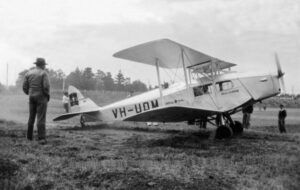
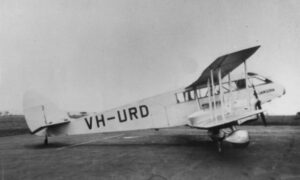
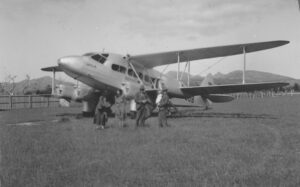
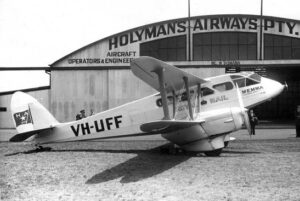
1931 – 1936
The Early British Commercial Planes in Tasmania
de Havilland were a major British aircraft manufacturer and their planes made up most of the airline fleet in Tasmania right through to 1939. They were biplane in construction and were made out of wood.
The early “Moth” series were single engined biplanes. The Gipsy and Tiger Moths had accommodation for a pilot and one passenger in open cockpits and were used for joy flights and training. The DH.83 Fox Moth was an enlarged version with a pilot and 3 passengers in an enclosed cabin.
de Havilland then manufactured a series of ‘Dragon’ biplanes designed specifically to serve the airline industry. The first was the DH.84 Dragon, then followed by the DH.86 Express and DH.89 Dragon Rapide.
The DH.86 with four engines, but could fly with two, was specifically designed for carrying passengers across water. It was not a successful design. Two of the four operated by Holyman’s Airways crashed in Bass Strait killing all on board.
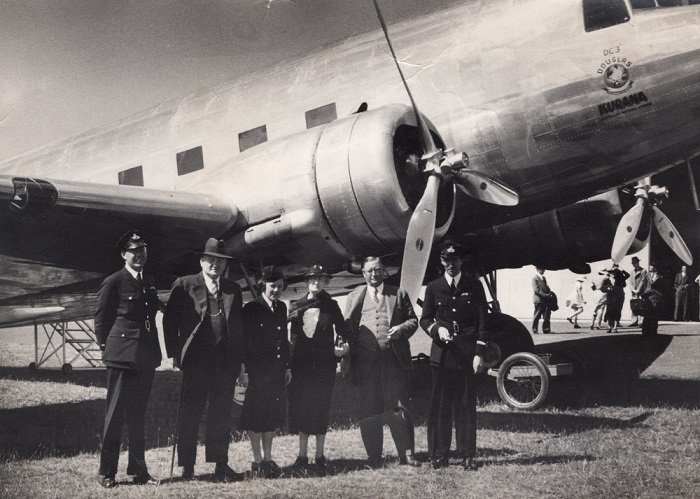
1936 – 1939
Modern Airliners Commence Bass Strait Services
Aircraft manufacturers in the United States developed all metal aircraft in the early 1930s but they were unable to be purchased by Australian Airlines until 1936. The Douglas DC-2 was used on the Bass Strait Service from 1936.
The DC-2 was significantly more advanced than the de Havilland Dragons. A monoplane constructed of metal, with a retractable undercarriage and a large spacious cabin for the passengers. The larger DC-3 was also used on the Bass Strait service from 1937.
Engine Technology
Early engines were notoriously unreliable but that changed towards the end of the 1920’s
The de Havilland Moths and Dragons used the Gipsy series of engines. These engines were air cooled “inline” engines of four or six cylinders. The DC-2 used Wright air cooled 9-cylinder ‘radial’ engines. Both these engine types proved to be very reliable.
Navigation Aids
Although pilots had a compass, they relied upon visually following land marks to plot their course. Takes-off and landing were only when the pilot could see the landing strip. If the aerodrome was covered in fog or cloud, the pilot was forced to divert to another landing strip.
The interstate passenger planes had radio communication with Melbourne and with Launceston from 1935. Their main role was to advise pilots of the local weather conditions.
Passenger services were only flown during the day, no night services were flown.
On 24 July 1936, the DC-2 Bungana was forced to abandon its schedule stop at Western Junction and instead land at Whitemark on Flinders Island. The Launceston Examiner Newspaper described the flight:
After leaving Cambridge aerodrome (Hobart) on schedule, the pilots, Messrs. F. T. Patterson and D. A. Ditchburn, were compelled to take the machine above the clouds. Low storm clouds covered Western Junction aerodrome, and the pilots continued on over Launceston in search of an opening in the clouds through which they could come down.
In view of the radio advice from the Western Junction station that the clouds were only a few hundred feet off the ground and that the visibility was poor it was too dangerous to make a blind glide through.
In search of a hole in the clouds through which the descent could be made, the machine continued on over Launceston, and eventually circled in bad weather off the coast. Thick cloud and appalling visibility made it impossible to continue the flight to Melbourne, and after two hours the flight was continued to Flinders Island, where the machine descended, to make a safe landing on the Pat’s River aerodrome
There were three passengers on the Bungana. The air hostess was Miss G. Blanch Due.
